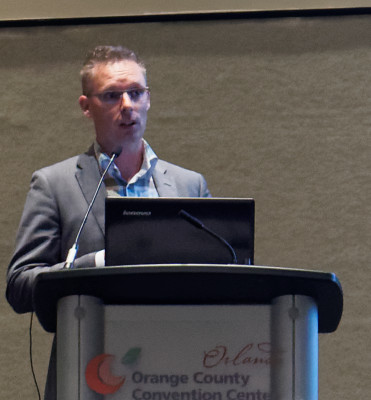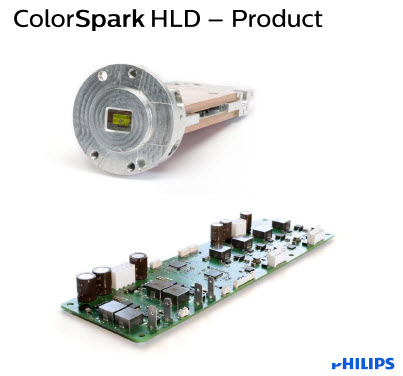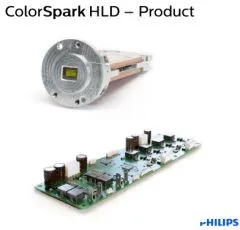
Peter Vankan is R&D Director for Philips Lighting which also has responsibility for projection light sources as well as general lighting.
First, Vankan looked back to 1994, when the company first made the UHP lamp and changed the projection industry. In 2004, the Vidi version of the lamp came along to improve the colour quality and ImageCare to improve contrast. Then came Image Life in 2013 which helped to deliver constant light output over lifetime. UHP will continue in innovation in the future and will not be made obsolete by the announcements he made.
Today is about LED, Vankan said, and in general lighting there is a dramatic change from lamps to LEDs.
More light is wanted for all applications. However, lighting has to become more energy efficient – 19% of all electricity used worldwide is for lighting. We’re entering the era of “digital light”.
In 2012, 18% of total lighting sales were based on LED but by 2016, 45%-50% of the market is expected to use LED.
Turning to projection – the “magic lamp” started the industry in the 19th century. By 1960, 35mm photographic slides were the main medium and in 1990 Overhead Projectors were introduced. Then, around 2000, digital projectors were introduced with analogue light sources.
In 2010, solid state lighting (SSL) was only 1.2% of the projector business and this has grown to 4% by 2014 but only in the 500-1000 lumens brightness range although laser phosphor is trying to increase its share.
In general lighting, LED has been around for a long time. The key in launching is to get to a “good enough” point, at the right price, then it can take off. Up to now, the SSL sources were simply not reaching the “good enough” point at the right price.

To solve this, Philips is introducing ColorSpark technology. Proectors are etendue limited systems – the amount of light that you can get out depends on getting the light into the system in an efficient way. Many LEDs are needed and there is no match to projector etendue. The ColorSpark technology uses colour conversion and light concentration to significantly improve the etendue match. Light from blue LEDs is converted to green and then trapped in a light rod and emitted in the right size and shape to match the projection imager. The concept is completely scalable – if you want double the light, you simply double the number of LEDs.
 Vankan said that current LED projection cannot get to higher brightness because of limits with green. Current LEDs are around 3.5-4K sr mm² in terms of output flux, but ColorSpark is around 16K. For now, the technology can support up to .65″ WXGA with 16 sr mm² and that allows projection systems up to 2,700 lumens already in Philips’ own prototype projector (it has no plan to re-enter the projector market). He said that over 3,000 Ansi lumens has been developed by projector makers using ColorSpark. A later product, the 4000 range (to boost red), will allow designs of 4,000 to 5,000 lumens.
Vankan said that current LED projection cannot get to higher brightness because of limits with green. Current LEDs are around 3.5-4K sr mm² in terms of output flux, but ColorSpark is around 16K. For now, the technology can support up to .65″ WXGA with 16 sr mm² and that allows projection systems up to 2,700 lumens already in Philips’ own prototype projector (it has no plan to re-enter the projector market). He said that over 3,000 Ansi lumens has been developed by projector makers using ColorSpark. A later product, the 4000 range (to boost red), will allow designs of 4,000 to 5,000 lumens.
Philips has set itself up as a one stop shop with a full design and drivers available. In response to a question, Vankan said that even though the current ColorSpark only supports green, it would not be available on its own. Those that want the green source, will also have to buy the sources for red and blue from Philips.
Insight Media did a test of four different projectors – and Chris Chinnock gave more details on the results later in the event. The higher saturation of ColorSpark meant that many of those that took part in test thought it was brightest. 68% thought it had the best picture quality. (Insight Reports on ColorSpark Testing (DS8)
Hitachi and Coretronic (Optoma) are partners for the development so far and both showed products at Infocomm.
In response to questions, Vankan said that 90% to 95% of the green light would be available with existing filters. Later, once the green bottleneck is passed, the platform will be developed.
In response to a question about lifetime, he said that the light output drops 10% after 10,000 hours and 30% after 20,000 hours according to the specification.
Analyst Comment
Philips pointed out that the “killer” part of the technology is that the material used for the blue to green conversion (and the firm would not be drawn on what this was) is that it is both very efficient, but is also transparent to green light. If it was not transparent, the rod itself would block the green light and reduce the efficiency. (BR)

